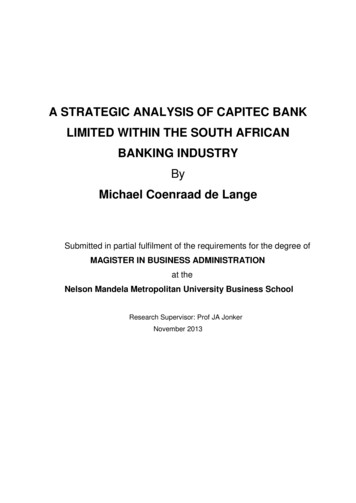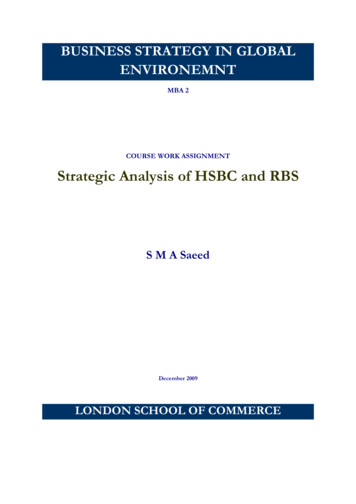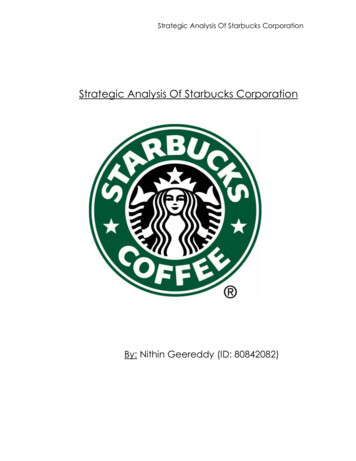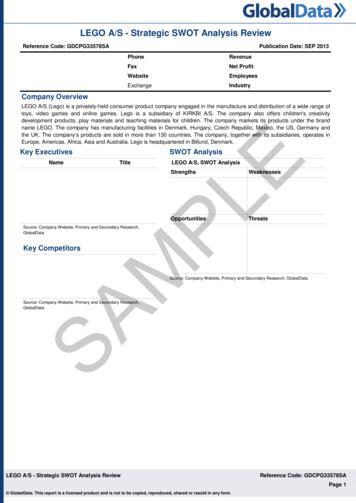
Transcription
A STRATEGIC ANALYSIS OF CAPITEC BANKLIMITED WITHIN THE SOUTH AFRICANBANKING INDUSTRYByMichael Coenraad de LangeSubmitted in partial fulfilment of the requirements for the degree ofMAGISTER IN BUSINESS ADMINISTRATIONat theNelson Mandela Metropolitan University Business SchoolResearch Supervisor: Prof JA JonkerNovember 2013
DECLARATIONI hereby declare that the above-mentioned treatise is my own work and that it hasnot previously been submitted for assessment to another University or for anotherqualification. I further declare that I followed all the applicable ethical guidelines inthe conducting the research.Signed: Michael de LangeDate: November 2013i
ACKNOWLEDGEMENTSThis research study would not have been possible to complete without the valuablecontributions and support of the following people: To my research supervisor, Professor Kobus Jonker, for his dedication,support and professional advice in helping me complete this study; To my girlfriend Jess, for all her understanding and willingness, her support,undying love and dedication in helping me throughout the duration of myMBA; To my family, for believing in me and providing the necessary support and forraising me to be a dedicated and disciplined individual in order to reach mygoals and complete this research study.DEDICATIONThis research treatise is dedicated to my late father who tragically passed away lastyear. He was an inspiration to us all and my hero. Gone but never forgotten. Thankyou Dad.ii
ABSTRACTThe South African banking industry is well regulated and oligopolistic by nature. Thefinancial sector in South Africa is of a world class standard, comparing favourably tothat of developed economies i.e. United States of America and Great Britain, anddeveloping economies such as the BRIC (Brazil, Russia, India and China) countries.The South African financial sector possesses the critical elements to exhibit goodgrowth and sustainable profitability.Capitec Bank Limited revolutionised the banking industry by providing a simplifiedand cost effective banking solution targeting the masses i.e. the “unbanked”population of South Africa. The company pursued a disruptive innovation strategyby targeting the lower income earning segment of the market i.e. individuals who areemployed but do not have a bank account.Capitec‟s strategic approach and business model were designed around innovationand technology, exploiting a previously untapped market that no other competitortargeted. This approach has resulted in the bank‟s phenomenal growth over the pastdecade and most notably has seen Capitec‟s return on equity (ROE) increase from12% to 26% and advances to customers increase from R116 million to R16 billion.This has set a precedent which the big four banks, namely ABSA, First NationalBank, Standard Bank and Nedbank, could not match.Contributing to Capitec‟s success and the basis on which its business model is builtare four pillars: accessibility, simplicity, affordability and personalised service. Thesepillars have created a competitive advantage resulting in the big four banks playingcatch up.A strategic analysis of Capitec Bank was conducted in order to assess the feasibilityof expansion by the bank into Africa. The conclusion of the study indicated that itwas indeed a viable option for Capitec to expand its footprint across borders intoAfrica through mergers with banks exhibiting a similar business model, for exampleEquity Bank based in Kenya.iii
TABLE OF CONTENTSCHAPTER ONE: INTRODUCTION AND RESEARCH OBJECTIVES1.11.21.31.41.5Introduction and background .1Research objectives .4Research questions .5Delimitation of the research .5Research methodology .61.5.1 Literature review .61.5.2 Strategic analysis .61.6 Limitations of the study .71.7 Significance of the research .71.8 Clarification of key concepts .81.9 Chapter outline .101.10 Conclusion .10CHAPTER TWO: LITERATURE REVIEW – SOUTH AFRICAN BANKING INDUSTRY2.1 Introduction .112.2 Strategic group map of the South African banking industry .122.2.1Key competitors .122.3 Industry analysis .152.3.1 Introduction .152.3.2 Environmental Analysis of the South African banking industry .152.3.3 Porter‟s Five Forces Model.172.3.4 SWOT analysis of the banking industry 212.4 Strategic stance and actions of the main players in the banking industry includingCapitec Bank .232.4.1 Introduction .232.4.2 ABSA .232.4.3 Capitec Bank .242.4.4 Nedbank .242.4.5 Standard Bank .252.4.6 First National Bank .252.5 Conclusion 26CHAPTER THREE: LITERATURE REVIEW – CAPITEC BANK LIMITED3.1 Introduction .283.2 History and background of Capitec Bank Limited .293.3 Capitec Bank Limited‟s ownership structure .313.4 Micro-lending financial institution landscape .333.5 Capitec Bank‟s business model .34iv
3.5.1 Capitec Bank‟s entry into the emerging market .373.6 Conclusion .39CHAPTER FOUR: THE STRATEGIC ANALYSIS OF CAPITEC BANK LIMITED4.1 Introduction .404.2 Capitec Bank‟s strategic approach to banking .414.3 Value chain, core competencies and competitive advantage .434.3.1 Sustainability of Capitec‟s competitive advantage .484.4 Analysis of Capitec Bank‟s business model .494.5 Capitec‟s product and process technology strategy .584.5.1 Introduction .584.5.2 Key Resource: Technology Strategy of Capitec Bank 584.5.3 Innovation Life Cycle and S-Curve for Capitec‟s Global One 594.6 Expansion into Africa .644.6.1 Introduction 644.6.2 Successful expansion into Africa: The case of Equity Bank Ltd . 65a.) History and background .65b.) Equity Bank‟s strategic approach .65c.) Equity Bank‟s business model .67d.) Comparison between Equity Bank and Capitec Bank .694.7 Conclusion .69CHAPTER FIVE: SUMMARY, CONCLUSION AND RECOMMENDATIONS5.1 Introduction .725.2 Research summary .725.2.1 Research objective and research questions .725.2.2 Synopsis of the literature review .73a.) Banking industry in South Africa . 73b.) The Capitec Bank business model and key success factors .75c.) Competitive advantage and strategic intent of Capitec Bank .79d.) Expansion into the rest of Africa .815.3 Recommendations .825.4 Further research .85LIST OF SOURCESv
LIST OF TABLESTable 1.1 Individual bank assets as at end June 2010 .2Table 2.1 Key financial soundness indicators – South African Banking industry .12Table 2.2 Low-cost transactional offerings in the South African bankingLandscape .13Table 2.3 ROE and Share Price Data in the banking industry .15Table 4.1 Difference between a Red Ocean and Blue Ocean strategy .41Table 4.2 Core competencies .47Table 4.3 Capitec Bank‟s Innovative Business Model .50Table 4.4 Innovation Lifecycle and S-curve – Global One .60Table 4.5 Technology Balance Sheet – Capitec Bank .63Table 4.6 Equity Bank‟s innovative savings led business model .68LIST OF FIGURESFigure 2.1 Selected strategic group map of the banking industry .14Figure 3.1 Capitec Bank Holdings Limited structure .32Figure 3.2 Capitec Bank Divisions .32Figure 3.3 Capitec Bank‟s growth in active customers .38Figure 3.4 Capitec Bank‟s growth in loans and advances .38Figure 4.1 Value Innovation .42Figure 4.2 Capitec Bank‟s Value Chain System .45Figure 4.3 Schematic representation of the unbanked market in South Africa .52Figure 4.4 Customers and profits of Equity Bank since 1994 .67Figure 5.1 Capitec Subsidiary Holdings .75LIST OF ANNEXURESANNEXURE A: Form E Ethics Clearance for Treatisesvi
CHAPTER ONE: INTRODUCTION ANDRESEARCH OBJECTIVES1.1INTRODUCTION AND BACKGROUNDSouth Africa has a well-developed and regulated banking system which comparesfavourably with those of industrialised countries (The Banking Association SouthAfrica, 2009). The banking sector has undergone many changes over the last20 years, with the early 1990s being characterised by a process of consolidation,resulting from mergers between a number of banks, including Allied, Volkskas andUnited to form the Amalgamated Banks of South Africa (ABSA). The other proposedmerger between Nedcor and Stanbic eventually ended in failure (The BankingAssociation South Africa, 2009).The promulgation of the Banks Act of 1990 had led to a number of banking licensesbeing issued and by the end of 2001 there were 43 registered banks in South Africa(The Banking Association South Africa, 2009). Saambou‟s financial troubles in 2002,however, resulted in a run on BOE and other smaller banks, which led to a numberof banks not renewing their banking licenses and others seeking financial assistancefrom foreign shareholders (The Banking Association South Africa, 2009). Otherbanks such as Regal Bank also ran into financial trouble at the time and were placedunder curatorship (The Banking Association South Africa, 2009).Although the South African banking sector has been through a process of volatilityand change, it has attracted a lot of attention internationally; with a number of foreignbanks establishing a presence in the country and others acquiring stakes in majorbanks (The Banking Association South Africa, 2009). An example of foreign banksestablishing a presence in South Africa is Barclays acquiring a major stake in ABSA,and the Industrial and Commercial Bank of China acquiring a major
pillars have created a competitive advantage resulting in the big four banks playing catch up. A strategic analysis of Capitec Bank was conducted in order to assess the feasibility of expansion by the bank into Africa. The conclusion of the study indicated that it was indeed a viable option for Capitec to expand its footprint across borders into Africa through mergers with banks exhibiting a .











